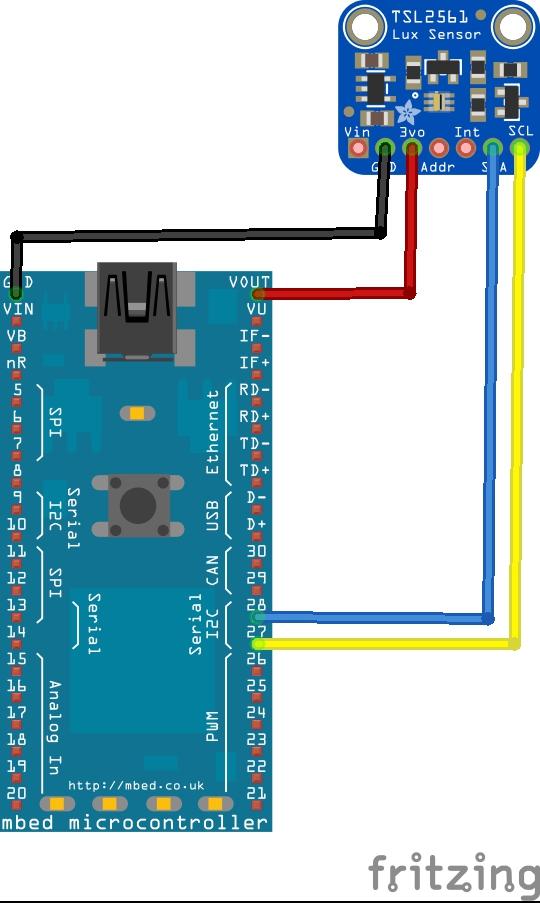The TSL2561 is a light-to-digital converter that transforms light intensity to a digital signal output capable of an I²C interface. Each device combines one broadband photodiode (visible plus infrared) and one infrared-responding photodiode on a single CMOS integrated circuit capable of providing a near-photopic response over an effective 20-bit dynamic range (16-bit resolution).
Two integrating ADCs convert the photodiode currents to a digital output that represents the irradiance measured on each channel. This digital output can be input to a microprocessor where illuminance (ambient light level) in lux is derived using an empirical formula to approximate the human eye response. The TSL2561 device supports a traditional level style interrupt that remains asserted until the firmware clears it.
Parts List
| Label | Part Type | |
|---|---|---|
| MBED1 | mbed LPC1768 | |
| Part2 | Adafruit TSL2561 |
Layout
Code
The following example uses the MBed online compiler and is imported from https://os.mbed.com/components/Grove-Digital-Light-Sensor/
[codesyntax lang=”cpp”]
#include "mbed.h"
#include "TSL2561.h"
Serial PC(USBTX, USBRX);
#define PC_PRINTX(z,x) if(z==1) PC.printf(x);
#define PC_PRINTLNX(z,x) if(z==1) {PC.printf(x); PC.printf("\r\n");}
#define PC_PRINTXY(z,x, y) if(z==1) PC.printf(x, y);
#define PC_PRINTLNXY(z,x, y) if(z==1) {PC.printf(x, y); PC.printf("\r\n");}
DigitalOut myled(LED1);
TSL2561 tsl2561(TSL2561_ADDR_FLOAT);
Timer setuptimer;
Timer executetimer;
void setup(void){
if (tsl2561.begin()) {
PC_PRINTLNX(1,"TSL2561 Sensor Found");
} else {
PC_PRINTLNX(1,"TSL2561 Sensor not Found");
}
// You can change the gain on the fly, to adapt to brighter/dimmer tsl2561 situations
tsl2561.setGain(TSL2561_GAIN_0X); // set no gain (for bright situtations)
//tsl2561.setGain(TSL2561_GAIN_16X); // set 16x gain (for dim situations)
// Changing the integration time gives you a longer time over which to sense tsl2561
// longer timelines are slower, but are good in very low tsl2561 situtations!
//tsl2561.setTiming(TSL2561_INTEGRATIONTIME_13MS); // shortest integration time (bright tsl2561)
//tsl2561.setTiming(TSL2561_INTEGRATIONTIME_101MS); // medium integration time (medium tsl2561)
tsl2561.setTiming(TSL2561_INTEGRATIONTIME_402MS); // longest integration time (dim tsl2561)
// Now we're ready to get readings!
}
int main() {
PC_PRINTLNX(1,"----------START-------------");
setuptimer.start();
setup();
setuptimer.stop();
PC_PRINTLNXY(1,"Setup time: %f",setuptimer.read());
setuptimer.reset();
uint16_t x,y,z;
while(1) {
// Simple data read example. Just read the infrared, fullspecrtrum diode
// or 'visible' (difference between the two) channels.
// This can take 13-402 milliseconds! Uncomment whichever of the following you want to read
executetimer.start();
x = tsl2561.getLuminosity(TSL2561_VISIBLE);
y = tsl2561.getLuminosity(TSL2561_FULLSPECTRUM);
z = tsl2561.getLuminosity(TSL2561_INFRARED);
executetimer.stop();
PC_PRINTLNXY(1,"Visible: %d",x);
PC_PRINTLNXY(1,"Full Spectrum: %d",y);
PC_PRINTLNXY(1,"Infrared: %d",z);
PC_PRINTLNXY(1,"Execution Time: %f",executetimer.read());
executetimer.reset();
//More advanced data read example. Read 32 bits with top 16 bits IR, bottom 16 bits full spectrum
//That way you can do whatever math and comparisons you want!
// uint32_t lum = tsl2561.getFullLuminosity();
// uint16_t ir, full;
// ir = lum >> 16;
// full = lum & 0xFFFF;
// PC_PRINTLNXY(1,"Visible: %d",full - ir);
// PC_PRINTLNXY(1,"Full Spectrum: %d",full);
// PC_PRINTLNXY(1,"Infrared: %d",ir);
// wait(1);
PC_PRINTLNX(1,"----------COMPLETE-------------");
}
}
[/codesyntax]
Testing
Using a terminal program such as Teraterm you should see something like
Visible: 372
Full Spectrum: 1764
Infrared: 2116
Execution Time: 1.213755
———-COMPLETE————-
Visible: 3818
Full Spectrum: 9853
Infrared: 2750
Execution Time: 1.213749
———-COMPLETE————-
Visible: 38
Full Spectrum: 221
Infrared: 164
Execution Time: 1.213792
———-COMPLETE————-
Visible: 46
Full Spectrum: 212
Infrared: 165
Execution Time: 1.213857
———-COMPLETE————-
Links
1pcs GY-2561 TSL2561 Luminosity Sensor Breakout infrared Light Sensor module integrating sensor AL


